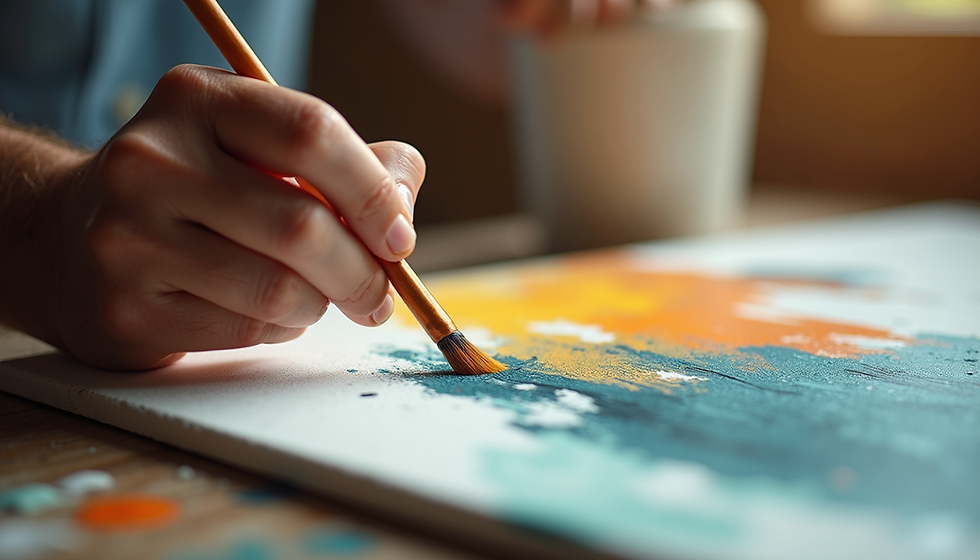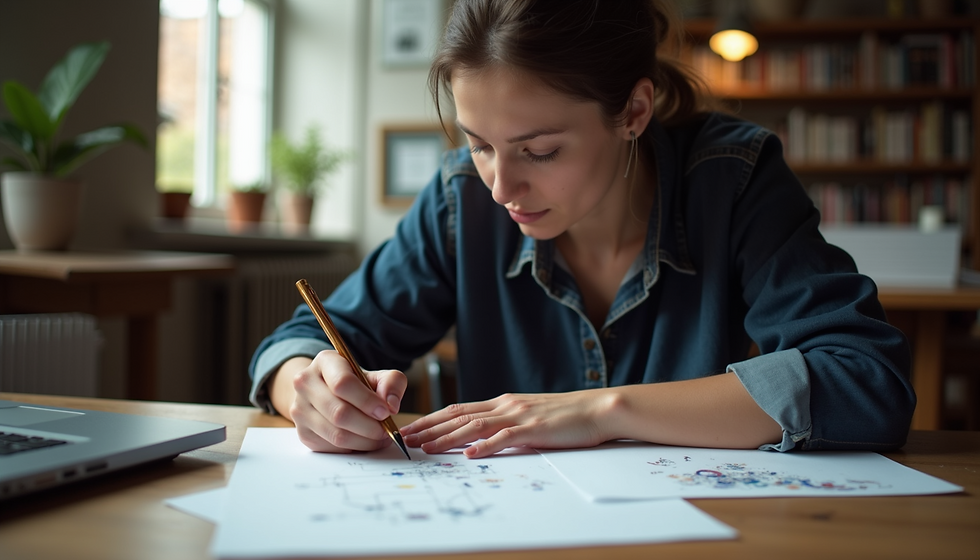How Art Therapy Nurtures Mental Well-Being: A Deep Creative Dive
- ArtSloth

- Aug 11
- 5 min read
Have you ever lost track of time while painting in your studio, only to look up hours later and realize the noise in your head had gone quiet? That’s not coincidence. What you’re feeling is the transformative effect of art therapy in action, whether or not you’ve ever called it that.
For artists, the act of making is already central to life. But when deadlines, exhibitions, and expectations creep in, our creative space can turn into a pressure chamber. Art therapy offers a parallel path: a place to make without the weight of outcome, where art becomes a practice of presence rather than performance.
What Is Art Therapy?
In its formal definition, art therapy is a therapeutic practice that uses creative processes like painting, drawing, or sculpting to support emotional healing and mental well-being. It’s guided by a trained art therapist, often in clinical or community settings, and emphasizes process over product.
But for practicing artists, the concept can live outside the clinic. It’s about intentionally using the tools we already have, brushes, clay, paper scraps — not for the sake of exhibition or sale, but as a private channel for self-reflection, emotional processing, and care.

The Science Behind the Brush
Art therapy’s power is rooted in how creativity interacts with the brain and body:
Cortisol Reduction – Even short creative sessions can lower cortisol, the hormone linked to stress and anxiety.
Dopamine Release – Engaging in art stimulates dopamine production, supporting mood regulation and motivation.
Neuroplasticity – Creative experimentation strengthens neural connections, improving adaptability and emotional resilience.
Parasympathetic Activation – The rhythmic, repetitive actions in art-making (like brushstrokes, kneading clay, or stitching) engage the body’s rest-and-recovery system.
These effects occur regardless of artistic “skill.” Your brain is responding to the act of making — not the quality of the final piece.
Why Art Helps: Emotional and Psychological Benefits
Stress Relief & Emotional Processing
The studio can become a sanctuary where external demands pause. Moving pigment across paper or weaving fiber through a loom can channel nervous energy into something physical and tangible.
Empowerment & Emotional Insight
Art offers a safe space to explore complex or painful emotions. Instead of verbalizing them directly, you can externalize them into color, form, or texture — creating emotional distance and new understanding.
Long-Term Well-Being
A sustained creative practice supports mental agility, problem-solving skills, and a stronger sense of identity, all protective factors for mental health.
Art Therapy Within an Artist’s Existing Practice
If you’re already a working artist, you might be thinking: I know making art helps me — that’s why I do it. But when your work becomes tied to deadlines, sales, or exhibitions, the act of creating can shift from being restorative to being another form of pressure. This is where adopting an art therapy mindset can quietly transform your practice.
Shifting the Intention
In professional practice, much of your time is spent problem-solving: How do I finish this in time? Will the gallery accept it? Will it sell? Art therapy invites you to set those questions aside and make simply for the act of making.
Try this in your studio:
Set a timer for 20 minutes.
Pick a material or subject you never use in your professional work.
Focus on sensation, rhythm, and play, not outcome.
Working With Emotional Energy
Artists are attuned to emotion, but that sensitivity can also lead to overwhelm or creative paralysis. Art therapy practices can help channel emotional intensity into low-pressure work that nourishes instead of depletes.
Consider keeping a shadow portfolio — a collection of experimental or private works never meant for public view. This can be a freeing space where rules don’t apply.
Materials as Mood Catalysts
You already know that materials shape mood:
For release: Charcoal, ink washes, collage ripping
For grounding: Clay work, weaving, intricate drawing
For uplift: Loose acrylics, bright watercolor, mixed-media play
Choose based on what your body and mind need that day — not what you think your audience expects.
Protecting the Non-Productive Space
Professional art rewards productivity. But creative longevity depends on protecting spaces where nothing is “useful” except to you. Keep these pieces unshared, un-photographed, or even destroyed afterward. This is maintenance, not waste.

Real-Life Spotlights: Healing Through Art
Aisha Banerjee, a self-taught painter, began using watercolor gradients to manage anxiety. These simple washes became abstract diaries, charting emotional shifts without a single written word. Over time, they formed a visual language only she could read — and that was enough.
Yayoi Kusama, a globally celebrated artist, has long used her work as a way to cope with mental illness. Her immersive polka-dot environments and endless nets are acts of meditation as much as they are public art. For her, repetition is refuge.
DIY Art Therapy Techniques for Artists
While art therapy is most effective with trained practitioners, you can adapt its principles into your personal routine:
Color Breathing – Paint strokes to the rhythm of your breath; each inhale adds, each exhale releases.
Emotional Map – Assign colors to your current emotions, then layer them into abstract forms.
Safe Space Collage – Use textures, images, and fragments that represent comfort; revisit it during stressful times.
Expressive Response – React visually to a poem, phrase, or sound, letting mood dictate medium.
Mindful Mark-Making – Repetitive patterns or strokes while focusing on sensory feedback.
Getting Started: Materials for a Therapeutic Studio Corner
For an artist, this doesn’t require a full supply list, it requires permission to use what you already own in unconventional ways. That half-empty sketchbook, leftover ink, or box of scrap fabric can become a playground. Keep a “therapy box” separate from your professional materials to remind you these sessions are for you alone.
Tips for Building a Gentle Practice
Start Small – Short sessions prevent overthinking.
No Witness Required – You don’t have to share this work.
Reflect Briefly – Jot notes on sensations, not critiques.
Let It Evolve – The practice may shift with your seasons and needs.
Why It Matters for Longevity
Many artists experience burnout not because they lose interest, but because they stop making art that exists outside of deadlines and audience expectations. Incorporating therapy-minded sessions ensures your relationship with making remains personal and restorative.

Conclusion: Your Everyday Creative Ally
Art therapy isn’t an “extra” for artists, it’s a way to keep the creative flame alive without burning out. It’s where you get to be your own first audience, where your brushstrokes answer only to you.
This month, set aside one session purely for your own mental and creative health. Whether it’s a chaotic collage, a meditative ink wash, or a page of messy marks, let it be yours and yours alone.
Your turn: Take 20 minutes this week to create with no intention of showing anyone. If you feel like sharing, tag it #ArtSloth, but the point is, you don’t have to.



